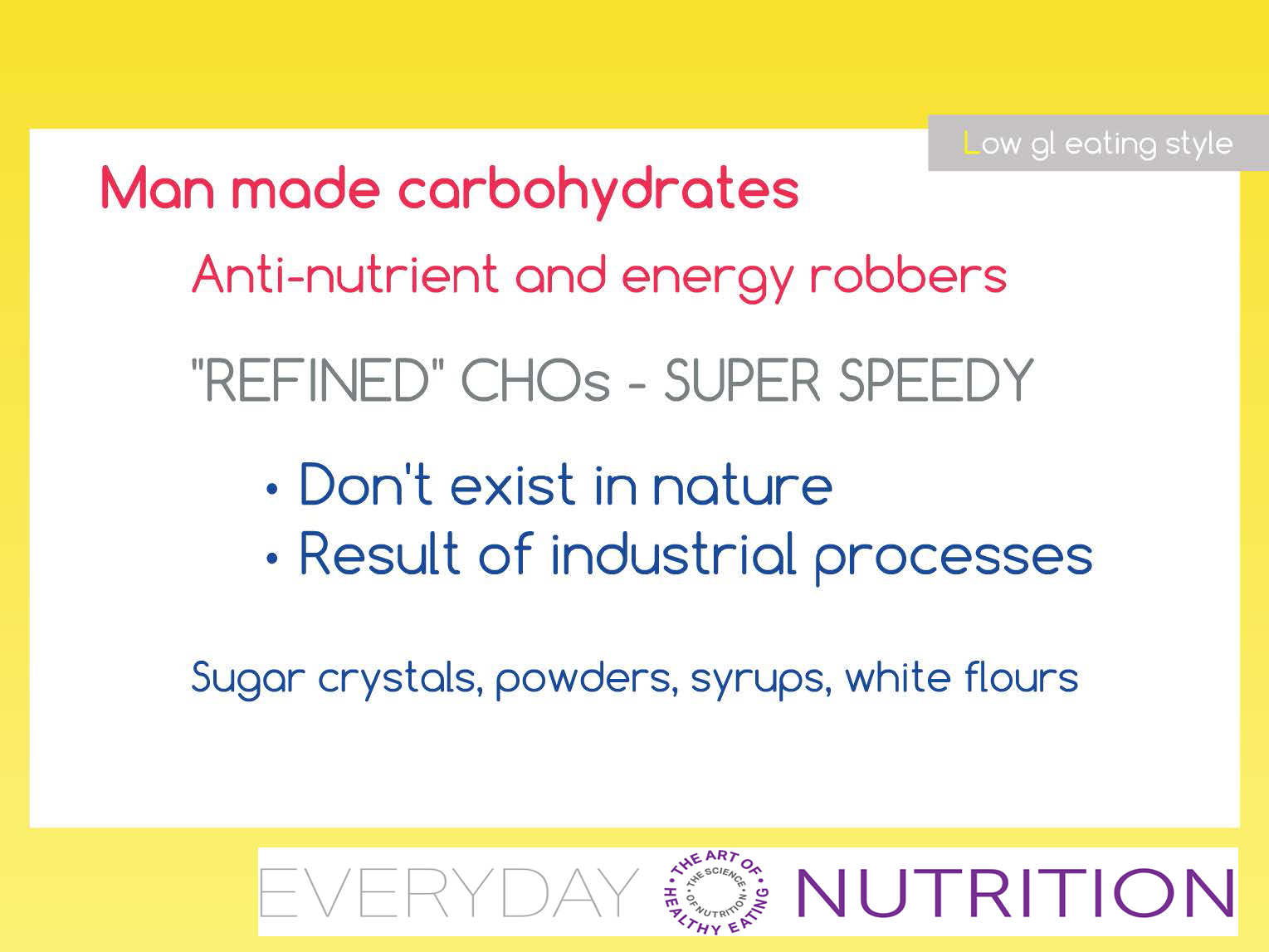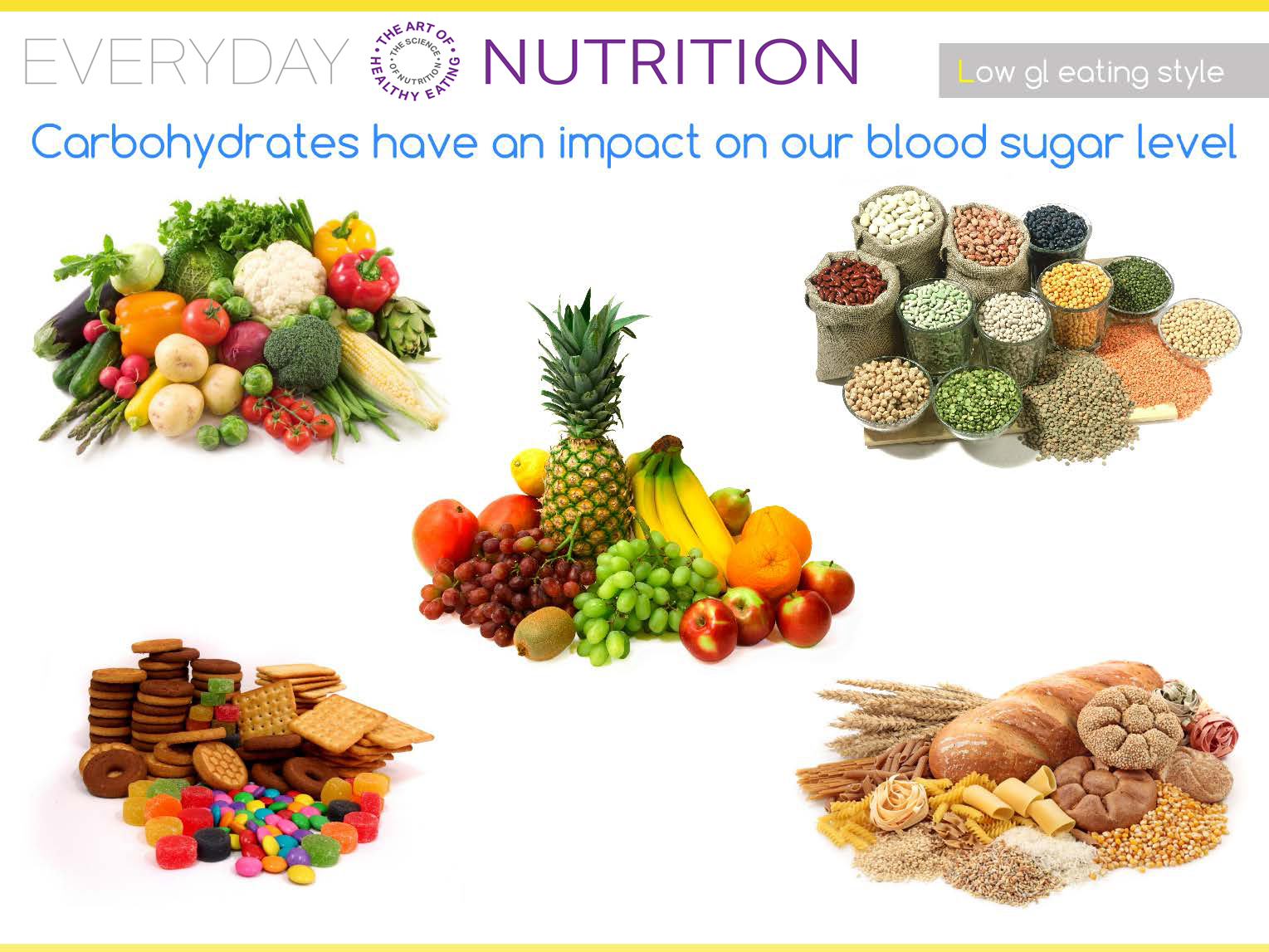Understand the different types of carbohydrates
and improve your energy, weight and long term health
Carbohydrates (CHOs), one of the main macronutrients in our diet together with proteins and fats, are found in fruits, vegetables, grains and derived products.
Chemically, for those of you so inclined 🙂 , they are organic molecules made up of carbon, hydrogen and oxygen. Plants “fix” atmospheric carbons by photosynthesis and form ring structures called sugars or saccharides. These sugars are then joined together to form larger molecules such as starch and fiber.
Let’s see the different types of carbohydrates and their role in blood sugar balance
Or, if you wish, go straight to the final part of this blog for your 5 step plan to choose the right carbs

The natural carbohydrates: real, whole and healthy!
The natural carbohydrates derived from plants can be divided into 2 main groups: Simple and Complex Carbohydrates.
The Simple Family contains small molecules of sugars such as glucose, fructose, lactose, sucrose and maltose. These sugars are, what I call, the speedy CHOs. They are “glycaemic carbohydrates” which means they are digested, absorbed and released into our blood stream.
They are, in fact, very easy and fast to digest because of their simple structure (1 or 2 molecules max) and are absorbed quickly by the cells of our gastrointestinal tract. They greatly affect your blood sugar balance causing sugar spikes and consequently cause high releases of insulin to correct the imbalance.
The Complex Family (so called as it includes longer and more complex molecules) includes “glycaemic” and “non-glycaemic” carbohydrates. Non-glycaemic carbohydrates are non-digestible and therefore not absorbed from our intestinal tract and thus do not affect our blood sugar balance.
The glycaemic CHOs are called polysaccharides or more commonly starches. These are also easy and fast to digest ( speedy CHOs) because, although their molecular structure consists of long glucose chains, the glucose molecules are kept together by weak chemical bonds ( a bonds) easily cleaved by our digestive enzymes.
The non-glycaemic CHOs come in 2 forms: oligosaccharides and fiber. These, although not digested and absorbed, are extremely important for our health as they prevent constipation, promote healthy gut bacteria, slow down gastric emptying, helping blood sugar control, support the elimination of cholesterol and used oestrogens, helps eliminating toxicity and an optimal intake is associated with reduced risk of hypertension, heart disease, colon cancer, diabetes type 2, kidney stones and many others conditions.
Each type of carbohydrate rich food contains a variety of CHOs, glycaemic and non-glycaemic but in different concentrations and this is the reason why CHOs rich foods have different glycaemic values.
The higher the amount of non-glycaemic CHOs in a food (oligosaccharides and fiber) the lower the GL of that food. Some CHOs rich foods also contains valuable amount of proteins (pulses such as lentils, dry peas, beans, chickpeas) and these also contribute to lower their GL value.

The “man-made” carbohydrates:
artificial, anti-nutrients and energy robbers!
So far I have been discussing the type of natural CHOs which you find in vegetables, grains and fruit. However, this is not the complete picture when it comes to sugars.
“Refined carbohydrates”, man-made sugars, extremely fast to digest and quick to absorb are a huge part of the modern western diet and cause havoc to our blood sugar balance. I am talking about CHOs which are the results of industrial processes of various type and degree, from refined grains, used to produce flours, to syrups, sugar crystals, powders and derived products.
They have no nutritional value and they are simply empty calories often accompanied by additives such as stabilizers, colorants, flavourings and preservatives, basically they come with their own added toxic load to complete the negative effects that they have on our health and weight!
Refined CHOs have very high glycaemic load and they are better avoided altogether.
GL recap
Just a quick recap for those of you who haven’t read my previous blogs:
The GL (glycaemic load) of a food determines the effect that it has on your sugar blood level and therefore has an impact in your energy levels, weight, moods, sugar cravings and long term heath. Ideally we aim at keeping the GL of each meal low to medium, depending on your individual health and weight goals.

5 step plan to choose your carbohydrates
and keep your blood sugar balanced,your long term health and a healthy weight
Aim at consuming a variety of CHOs rich foods which are high in non-glycaemic CHOs such as fiber and lower in glycaemic CHOs such as simple sugars and starches.
For your health, weight and energy levels it is important that you consider the glycaemic load of your plate and that you keep it low – to- medium GL (max 20 GL in total per meal).
Although it might seem complicated, it is actually very straight forward and you can start doing this by following these simple steps:
1- Choose real food and keep it whole – avoid refined grains – avoid anything that is white such as white breads, white pasta and white rice.
2 -Choose only one type of starchy rich food – either one type of starchy veg or one type of grains – and moderate its amount by covering only ¼ of your plate- see list below for choices.
3- Always look at your plate and ask yourself: where are my proteins?
4- Always include some healthy fats in your plate as these will satisfy your taste buds and will help you keeping unhealthy cravings under control.
5 -Avoid refined carbohydrates (anything made out of refined flours, biscuits, confectionaries, cakes, sweets, muffins, chocolate bars, crackers etc.).
Starchy vegetables
Beetroot
Butternut
Parsnips
Potatoes
Pumpkin
Swedes
Sweet potatoes
Yams
Whole grains
Amaranth (GF)
Barley
Buckwheat (GF)
Bulgur
Corn (GF)
Farro
Freekeh
Kamut
Millet (GF)
Oats (GF)
Quinoa (GF)
Rice (GF)
Rye
Sorghum (GF)
Spelt
Teff (GF)
Triticale
Wheat
(GF=naturally non containing gluten)
Finally
Not all carbohydrates and sugars are the same and don’t all deserve to be demonized… remember that glucose is, after all, the preferred type of fuel for the majority of our cells.
It is therefore important to have the right type of carbohydrates rich foods in our diet and is also important to remember that natural carbohydrates rich foods are high in micronutrients (vitamins and minerals) and phytonutrients (beneficial chemicals) which are essential for our health.
So be carbs wise, keep it low ( in GL ) and keep it whole .
But above all keep it real!
Wishing you vibrant vitality






0 Comments